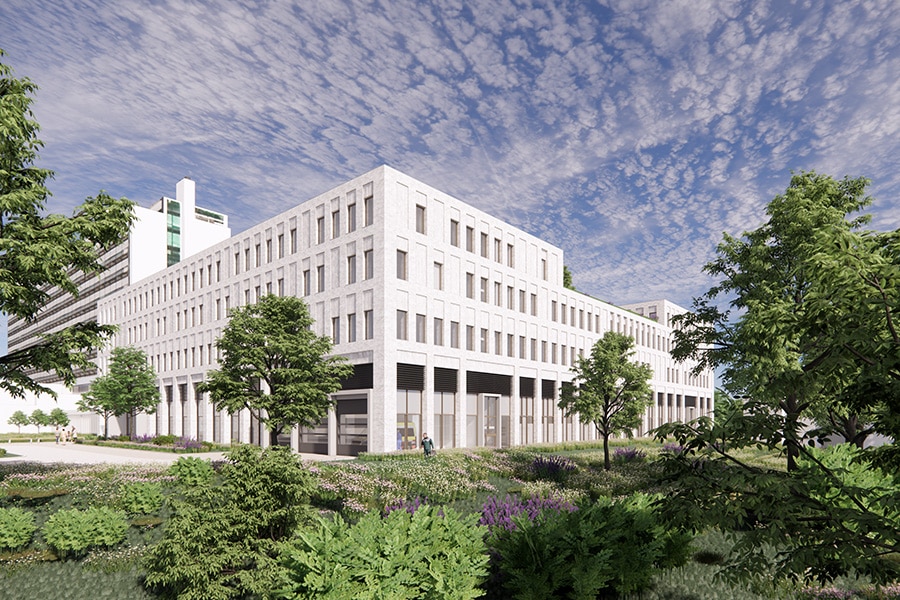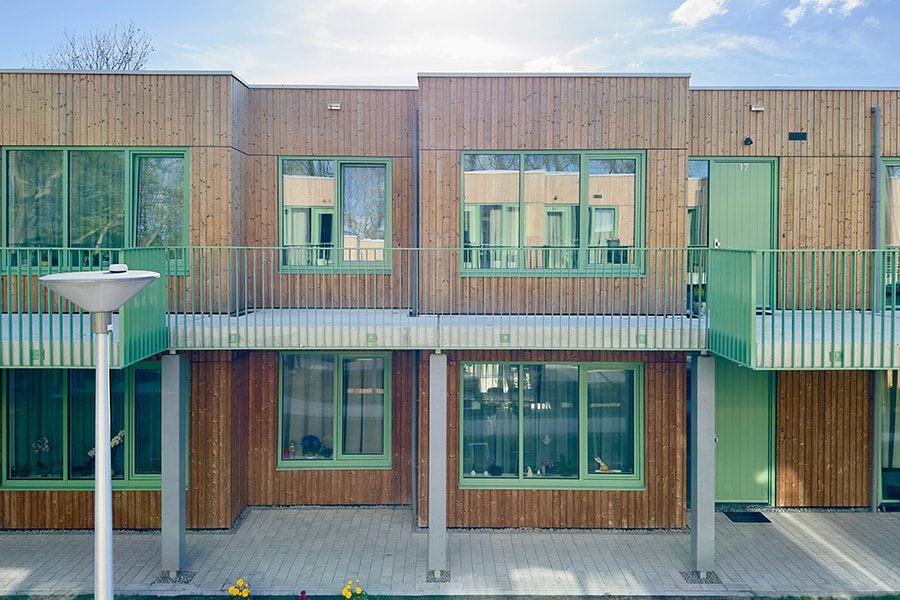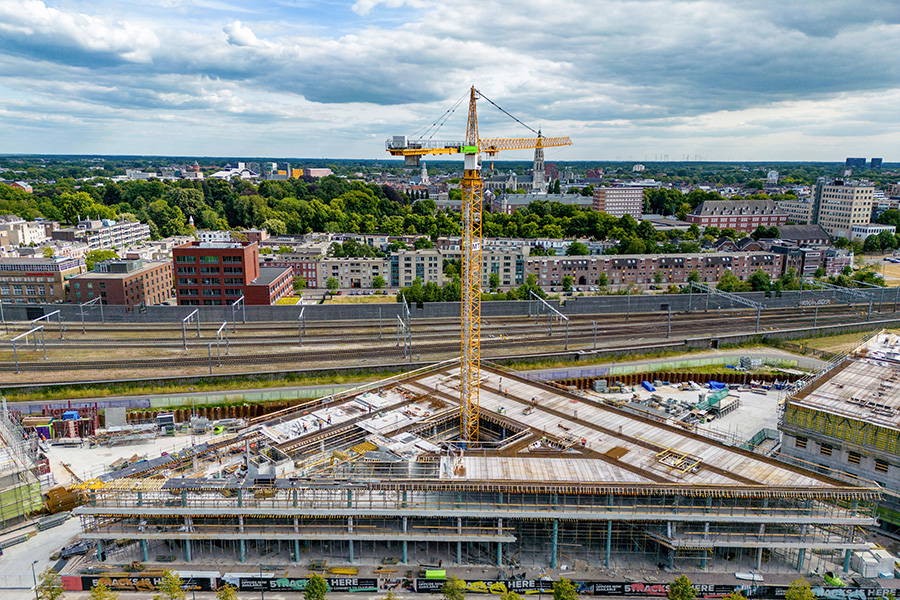
Feringa Building in full completion phase
New building for Science and Engineering faculty at the University of Groningen begins to take shape
Back in January of this year, Stedenbouw extensively featured the plans for the construction of the new Science and Engineering faculty at the University of Groningen. A prestigious project brimming with innovations, including maximum transparency and earthquake-resistant features. What's the status of construction now? We get an update on the status from the mouth of Marc Harks, project director at main contractor Ballast Nedam.
Modern and transparent building shows
In recent months, construction has continued apace. "The shell construction of the first phase is finished," Harks opens the conversation. "The facade closure is also largely complete, making the building wind and watertight. So we are now in the finishing phase. Think of laying the floor covering, installing the interior walls and interior frames and assembling the mostly glass system walls."
Designed by Ector Hoogstad Architects, the Feringa Building will be a modern and transparent building with lots of glass. Harks: "In many ways it is a welcome upgrade to the faculty's existing accommodation. Ballast Nedam is happy to collaborate on the realization of this beautiful design, which will provide excellent facilities for researchers, staff and students of
the faculty."

Setting up the laboratories
Wesemann Projects BV began furnishing the labs more than two months ago, including installing about 3 km of lab tables and 450 fume hoods. "Feringa Building will also get a wide range of special labs, including laser labs, clean rooms and physical, (bio)chemical and vibration-free labs. The moment the lab equipment is in place, installation combination De Groot & Lammerink can finally connect the equipment and further complete the commissioning of the complex. It requires the necessary coordination between the various disciplines to properly align all activities," Harks concludes.
Eyecatcher of the project
From the air, the central atrium is now clearly visible. "The covered interior space will be the eye-catcher of the building. On the second floor there will be space for events and exhibitions. Several meeting rooms and lecture halls are adjacent to the atrium, and a large auditorium with over 400 seats will be built under the atrium. The so-called 'yellow houses,' the distinctive yellow meeting rooms on the 1st floor, are also easily accessible from the atrium." The atrium will be equipped with a so-called air cushion roof, which consists of four pressurized layers of plastic films. The roof insulates and regulates light access to the atrium by varying the air pressure, with the two middle foils providing more or less light. For Ballast Nedam, the focus is now on making the 22-meter-high curtain wall under the atrium canopy wind and watertight, after which finishing work in this area can also be fully started.

Sustainable building
Approximately 900 m2 of solar panels will be installed on the roof of Feringa Building. However, that is not the only sustainable measure: "Building materials with a high insulation value were naturally chosen in the design. Compared to the faculty's current location, energy consumption will be significantly reduced." Another example are the green roofs, which insulate and contribute to biodiversity.
Completion
The project consists of 2 phases. Harks explains, "We are now working on phase 1: the first five of the six wings. This sixth wing (phase 2) will be on the spot where the old University of Groningen building is now in use. In the summer of 2023, phase 1 is expected to be completed and the RUG will start moving employees and students from the old building to the new building. After this, this building can be demolished and we expect to start phase 2 in the spring of 2024. We expect final completion by the end of 2025."

Some facts and figures:
- 260 meters long, 63 meters wide
- 5 stories
- Lecture hall with 420 seats
- Restaurant with 250 seats
- 3 kilometers of lab tables
- 450 fume hoods
- 35 laser labs
- 900 m2 of solar panels
- completely natural gas-free
Feringa Building, Groningen: Special eye-catcher with 18,000 anodized wobblers
From 2023, the Feringa Building of the University of Groningen (RUG) will be the new eye-catcher on the Zernike Campus. The impressive new building has been designed by Ector Hoogstad Architects as three cleverly linked V-wings. For the facade finishing, about 12,000 m2 of window frames and curtain walls were chosen, in combination with about 18,000 anodized aluminum composite panels in a characteristic wieber shape. The panels will be engineered and produced by Aldowa under subcontract to Ballast Nedam. Moreover, the market leader in metal and aluminum composite cladding is responsible for the assembly.
Text | Lieke van Zuilekom Image | Aldowa
"Spread over the three wings, about 13,000 m2 of anodized aluminum composite panels will be installed," explains Martien Trouborst, project manager at Aldowa. "We chose panels in five anodization shades (4x gray and 1x champagne), which will be mounted randomly and roof tile wise on the different facades. For each facade, we determined the most optimal dimensions in consultation with the architect. Moreover, we made the design visible and tangible in a mock-up. After approval, we started production."

Each wieber involves an aluminum composite panel that is carefully milled and folded at Aldowa's plant in Rotterdam, Trouborst said. "On site, the HSB elements and Primo cladding of the facade are fitted by our assembly people with aluminum brackets and corner lines, to which the panels are screwed. We started the assembly work in November 2021." Meanwhile, half of the facades have been clad with composite panels. This gives the building a beautiful appearance, Tourborst concludes. "The cooperation with Ballast Nedam is good and Aldowa Composites is proud of this special, Groningen eyecatcher!"
Durable, lightweight solution for atrium roof
For the atrium in the new Feringa Building at the University of Groningen, the Netherlands, architect and contractor were looking for a material with low weight. That made ETFE a perfect solution. Indeed, its long service life and light weight make this ethylene-tetrafluoroethylene copolymer extremely durable. Thus, less steel is needed, resulting in a lower ecological footprint.
Text | Johan Debaere Image | Ballast Nedam
The atrium is equipped with a 1,000 m² variable roof that provides an attractive indoor climate as well as shade when needed. This is the advanced ETFE system from Vector Foiltec. To create optimal operation, this company also took care of the steel construction and installation of the gutter systems.
The cushions for the university building are constructed of four layers of ETFE film. An air supply system pumps air between the layers so that they expand or contract. In the process, the printed layers in the cushions provide more or less shade. The system can be easily adapted to different climatic conditions and scores highly in terms of thermal performance and solar control. The latter is achieved by the sophisticated printing technology, which reduces light transmission. In addition, this ETFE system from Vector Foiltec offers fire safety and improved acoustics, making it an excellent choice for atrium roofs. Furthermore, the ETFE system requires minimal maintenance and its long service life of more than 50 years stands out.

With eighteen offices worldwide and factories in Germany and China, Vector Foiltec delivers worldwide. The company is a market leader in elegant and cost-effective technical solutions for roofs of atriums, facades and domes, among others. In the Netherlands, they have been used for Burgers' Zoo, the Rotterdam Floating Pavilion and the Johan Cruijff ArenA. The Chinese prestige project Water Cube, transformed into Ice Cube for the 2022 Winter Olympics, is also equipped with Vector Foiltec's ETFE system.



